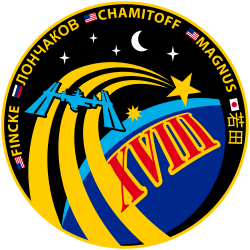 Promotional poster | |
| Mission type | Long-duration expedition |
|---|---|
| Expedition | |
| Space station | International Space Station |
| Began | 12 October 2008 |
| Ended | 8 April 2009 |
| Arrived aboard | Soyuz TMA-13 Chamitoff: STS-124 Space Shuttle Discovery Magnus: STS-126 Space Shuttle Endeavour Wakata: STS-119 Space Shuttle Discovery |
| Departed aboard | Soyuz TMA-13 Chamitoff: STS-126 Space Shuttle Endeavour Magnus: STS-119 Space Shuttle Discovery Wakata: STS-127 Space Shuttle Endeavour |
| Crew | |
| Crew size | 3 |
| Members | Michael Fincke Yuri Lonchakov Gregory Chamitoff* (October–November) Sandra Magnus (November–March) Koichi Wakata† (March–April) * – transferred from Expedition 17 † – transferred to Expedition 19 |
| EVAs | 2 |
| EVA duration | 10 hours, 27 minutes |
 Expedition 18 mission patch  (Left to right) Koichi Wakata, Michael Fincke, Sandra Magnus, Yuri Lonchakov, Gregory Chamitoff | |
Expedition 18 was the 18th permanent crew of the International Space Station (ISS). The first two crew members, Michael Fincke, and Yuri Lonchakov were launched on 12 October 2008, aboard Soyuz TMA-13. With them was astronaut Sandra Magnus, who joined the Expedition 18 crew after launching on STS-126 and remained until departing on STS-119 on 25 March 2009. She was replaced by JAXA astronaut Koichi Wakata, who arrived at the ISS on STS-119 on 17 March 2009. Gregory Chamitoff, who joined Expedition 18 after Expedition 17 left the station, [1] ended his stay aboard ISS and returned to Earth with the STS-126 crew.
